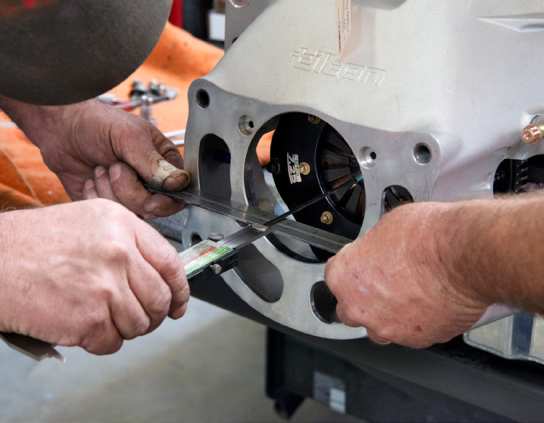
Since Big Red is using a Tilton 7.25-inch flywheel multi-plate clutch setup, the flywheel is too small to work with a starter mounted in the standard location. The crew had to get a Tilton bellhousing that places the starter closer to the center line of the crankshaft where it can reach the flywheel. The brand new Tilton bellhousing and hydraulic release bearing arrived. It’s within Tilton’s specifications, so the transmission input shaft and pilot bushing will be safe. Time to cut it up. The first pieces to remove were the wide mounting ears on both sides of the bellhousing. Dave would have left the mounting ears in place if Big Red ran a mid-plate, but they were simply excess weight and in the way.
Just because Tilton checked the concentricity of the register bore (large transmission-centering hole in the bellhousing) doesn’t mean that the engine block is within tolerance of Tilton’s jig. Something as simple as a line-hone can change the crankshaft center line and require bellhousing realignment. Dave wouldn’t think of taking someone else’s word for the work he needs to sign off. To start, Dave installed a set of temporary bellhousing dowel pins made from tubing. If the measurements were off, he could install a set of offset dowel pins.
To check the concentricity of the bellhousing, Dave bolted the bellhousing to the block. Without the clutch and flywheel installed, he attached the magnetic-base dial indicator on the crankshaft. He checked for register bore run out. The measurement was within spec without offset dowel pins. Dave checked the installed height of the clutch release bearing in the bellhousing. Then he removed the bearing from the bellhousing before bolting it to the engine.
The flywheel, clutch, and then the bellhousing were installed; then they measured the distance between the transmission mounting face and the clutch diaphragm springs. This allowed Dave to calculate the proper installed height of the release bearing. The release bearing standoffs were too tall, which isn’t uncommon. Luckily, Tilton casts the release bearing standoffs on the taller rather than the shorter side. Dave put the bellhousing in the mill and cut the standoffs down to the proper height. Tim installed the Tilton release bearing and its hydraulic lines in the bellhousing. The bulkhead fittings are threaded into the bellhousing for a clean and compact installation.

During the process, Tim bolted the transmission to the bellhousing a couple of times. The witness marks on the transmission show that it was a good, tight fit to the register hole. He had to sand the layer of paint off the register boss. Dave confirmed that the clutch release bearing is the proper distance from the clutch diaphragm springs. Tim test fitted the transmission to the new clutch to make sure the input shaft and clutches mesh properly. This whole process of dialing-in the bellhousing register hole had to be done with the spare engine, too. That way, there’s one less thing to do when an engine swap is required.